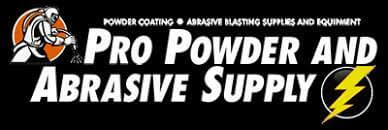Industrial > Abrasive, Sandblasting and Soda Blasting
Powder Coating Guns:
There are two basic types of powder coating systems to consider, each with their own strengths and weaknesses: Corona and Tribo. The core difference is the way the powder is transported from the powder coating gun to the part. The primary force for material transport in Corona powder coating system is an electric field established between the charged powder cloud and the part. In the Tribo powder coating system, material transport is from the velocity at which the powder is liberated from the powder coating gun, that is, from the air flow provided by compressed air.
Corona powder coating guns use a high-voltage generator to disassociate air and produce a stream of negative or positive ions, which in turn imparts a like charge to the powder cloud. The potentials of the charged cloud and gun electrode combine to generate an electric field with the opposite pole (the part). Charged powder particles at the gun seek the lower potential of the opposite pole (the part).
Another fundamental difference between Corona and Tribo powder coating systems is the method in which the powder particles become electrically charged. The Corona gun uses a high voltage generator to charge an electrode to a high potential relative to the part. The charged electrode disassociates air and generates a flood of charged particles, effectively charging the powder cloud, creating a charged field with the opposite pole.
In contrast, the Tribo gun imparts a charge to the powder strictly by physical contact and movement between the powder and a surface capable of donating or receiving electrons. Powder transport is strictly by the velocity at which the powder is liberated from the gun.
Generally speaking, tribo technology is the best choice when:
applications requiring the best possible appearance
parts constructed of materials with low charge conductivity, part geometry’s susceptible to the generation of Faraday cage areas
applying powders with a low degree of abrasive, such as many non-metallics
parts requiring a thin coating
parts requiring the highest degree of coating uniformity
touch up applications
epoxy coatings
While generally speaking, corona technology is the best choice for:
parts constructed of materials with a higher charge conductivity
part geometry’s not susceptible to the generation of Faraday cage areas
applying powders with a high degree of abrasive, such as many metallics
parts requiring a relatively thick coating
multiple custom coats
The term “100 kV” applies to Corona guns and refers to the 100,000 high-voltage generator that produces the arc to disassociate air and generate an electron cloud. The electrode of the gun typically has a negative polarity relative to the piecework. Polarities must be reversed for nylon powders, which require a positive charge. Corona powder coating guns with low kV values (some as low as 16 kV) raise significant questions about the quantity of charged particles that such a low kV can generate. To learn more about the operation of powder coating equipment including powder coating systems, powder coating batch ovens and powder coating booths consider attending a powder coating training class such as that offered by the Powder Coating Institute.

Details
- Last Updated
- 16/Sep/2025
- Contact
- Tim Rouze
- [email protected]
- Phone
- (916) 992-0968
- Website
- http://www.propowdersupply.com/
- Address
- 5710 Auburn BlvdSacramento, CA 95841
